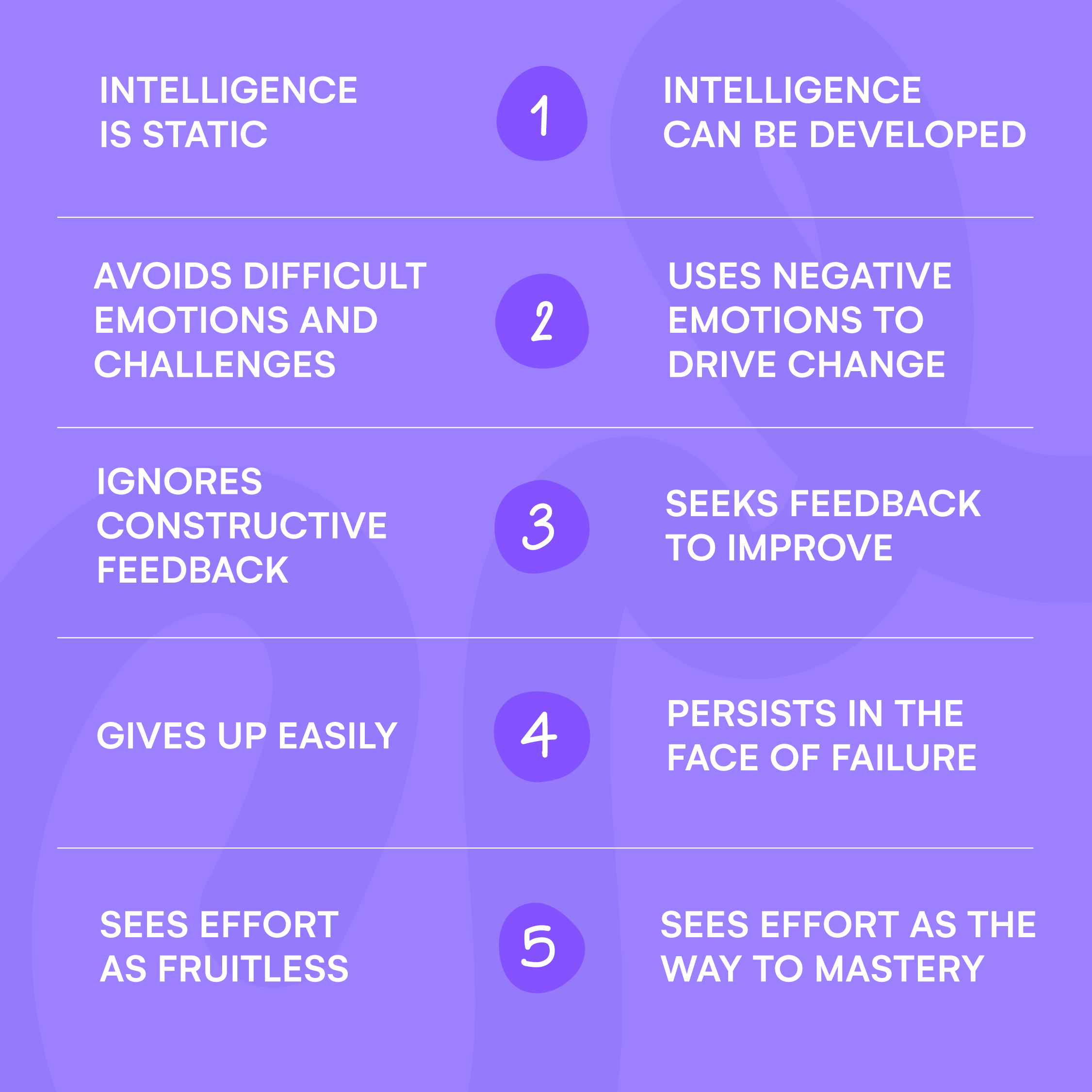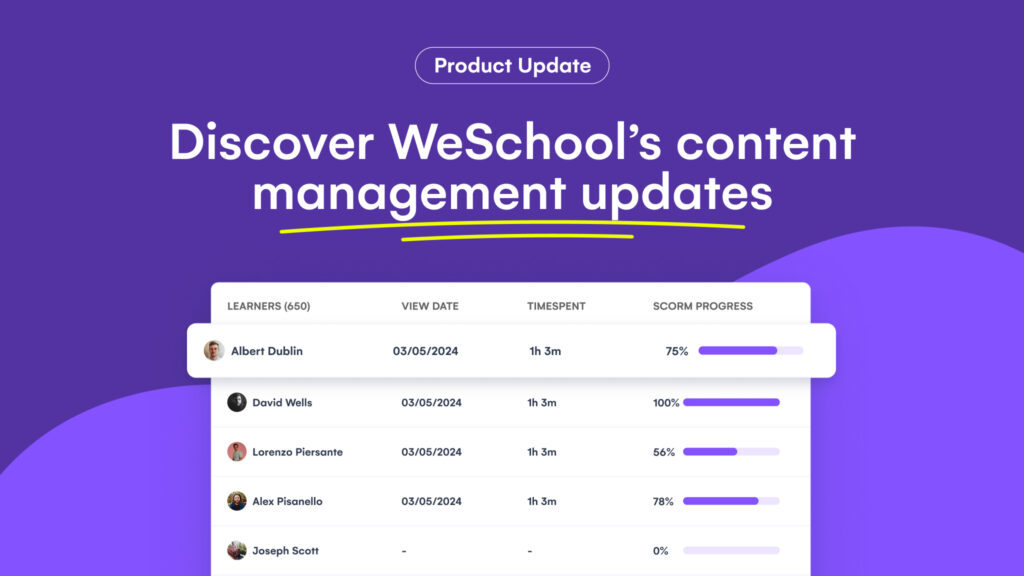While in today’s world of professional growth and leadership we’re all passionate about data, sometimes we underestimate the profound influence of our thoughts on our daily jobs. In the end, it’s our mindset that shapes the way we tackle challenges, adapt to change, and flourish. But how does one change their mindset? And most importantly: how does one change their team’s mindset?
Spoiler alert: it’s our actions that set the change in motion. And here is where team leaders’ responsibility comes into play. In this article, we will guide you through the opinions and tips of managers, HR, and learning professionals who have been questioning themselves about the importance of nurturing a growth-oriented mindset in the workplace.
This new approach to shared mindset and culture can actually revolutionize how your team members approach their daily challenges, tasks, and meetings, down to the smallest “We tried this, but it didn’t work.”.
A fixed mindset brings individuals to view their intelligence, skills, and strengths as unchangeable. On the other hand, someone with a growth mindset views those same traits as learnable and capable of improvement through effort. When they don’t know how to do something they address why they can’t do it by closing the knowledge.
In the realm of the workplace, you’ll encounter individuals with varying degrees of confidence in their creative problem-solving abilities. However, the greater the number of team members who possess self-assuredness and a desire for growth, the more vibrant and innovative solutions will fuel the collective effort of the team.
That’s why, if you think a growth mindset will impact only the actions and attitudes of individuals, you’ll be surprised to learn that your team’s overall skills will also benefit from a shift in this direction.
After chatting with hundreds of team leaders and human resources professionals in the past few months, we’ve found four constant elements that come with growth-first mindset leadership:
Individuals are more likely to seek out new skills relevant to their roles when they want to get better at it. When people are intrinsically motivated, team leaders can focus more time on support and quality feedback.
Constructive self-talk and openness to feedback create a more harmonious and productive working environment. When team members are receptive to others’ feedback, they can identify areas for improvement and work together more effectively.
A growth mindset makes people aware that challenges are there to be faced in the first place, making everyone accountable for their need to try, fail, and try again until they succeed.
If pushing your team to grow, take ownership, and think differently pushes them away, it will make room for those who thrive in doing exactly that. With a growth mindset culture, your organization will become a desirable place to work for the right people.
For decades, our approach to workplace learning has been focused on outcomes and results. However, if we base our pursuit of success on a foundation of scarcity, such as “we lack these results,” it’s no surprise that our teams may end up operating from that same place of fear. They might be driven by thoughts like, “I need to achieve this, or I won’t be good enough.”
But let’s switch gears and consider this notion: what we need are managers who genuinely believe in their own (and therefore their team’s) capacity for growth. It’s all tied to what we could simply call the “mindset-supportive-context hypothesis.” Don’t fret; it’s far less complicated than it sounds: we’re talking about the idea that managers must first internalize this belief through dedicated mechanisms before they can effectively weave it into the fabric of their team’s daily routine.
Now, that brings us to a vital point: fostering a culture of fear won’t lead to growth. What managers need to focus on is creating a positive and resilient environment by taking proactive steps.
This involves building a workplace where team members feel empowered, supported, and encouraged to cultivate a growth mindset. By doing so, they pave the way for their teams to thrive and reach their full potential.
Now that we know the difference between each mindset and understand the importance of adopting it in the first place if you want to bring it to your team, let’s look at how to instill this change among teams.
Let’s do some role play: Let’s imagine you’re a manager and you now believe people can change. How do you take your team from “I can’t” to “I can’t right now, but if we did this I might be able to?”.
The first step is changing the way you approach individuals: focus on the process over the outcome. If we only reward the people who succeed, we may be slowly discouraging those team members who’ve tried different things and have not yet found what moves them.
We summed up three actions the managers we’ve been talking to consider essentials in order to bring the change into their teams’ attitude – yes, it all starts from practice.
1. Set your team up for challenges regularly
Solving problems and having to think of new ways to get there promotes self-efficacy and confidence. A simple way to do this is by defining shared goals that are tough but doable.
You can do this by increasing accountability bit by bit. Talk to your team members about their potential and growth, and create ways for them to learn the skills they need for their current and future job.
2. Define a self-evaluation model
According to Janet Mizrahi, a lecturer of professional writing at the University of California, “without thinking deeply about how we learn, we can never gain the insight necessary to correct poor habits and affirm good ones”. In a nutshell, it’s essential to be aware of what we’re good at and where we need to improve, planning how to get better in the end.
Our tip? Encourage your team members to reflect on how they do their work with detailed growth plans. This helps them plan how to achieve their learning goals, ask for feedback to get better, fix mistakes when they make them, and figure out what support they need.
3. Gamify the task achievement process
A growth mindset is influenced by how people perceive their creative ability (Yu-chu Yeh, Yu-Shan Ting, and Jui-Ling Chiang, 2023). Which is why cultivating creativity in everyday tasks is so important. So, what about inspiring creativity through gamified leadership techniques?
Implementing a playful approach to your team’s daily tasks doesn’t have to be a formal or structured process. It can simply be leveling projects into tasks that become more challenging as they are completed. In the end, it all comes down to presenting each new task as a challenge to be faced in a non-structured way.
If you’re curious to read more about the growth mindset and find ways to instill this way of thinking among your teams? Browse through these curated resources to help deepen your knowledge. From industry leading books to an excellent podcast to listen on the go, there will be at least one that brings value to your team:
The foundational text! Read Carol’s book to shift your team’s mindset from fixed to growth.
Learn how to organize the learning process for your team to perform at their best in under an hour with Dave Edoardo.

An article including lessons from world-successes like Serena Williams to drive your team’s transformation mindset.
Get inspired with this TED Talk by learning about Surbhi’s journey from a place of fear to stepping into a growth mindset.

Learn valuable insights to transform your team’s thinking and habits at work with this self-help book.
Independently from the hard skills we develop, the mindset we bring to our daily tasks and challenges is the true secret weapon. In this article, we’ve ventured into the distinction between fixed and growth mindsets and uncovered the advantages that come with nurturing a growth-oriented outlook.
A growth mindset represents a paradigm shift waiting to empower your team. It creates an environment of continuous learning, where individuals eagerly seek new skills and knowledge. This, in turn, fosters a team culture that’s not just adaptable but also highly skilled, perfectly poised for success in our ever-shifting business world.






Reviews